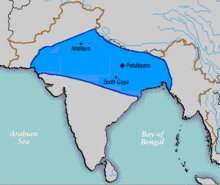Nanda empire
The Nanda Empire was established in the middle of the 4th century BC. Chr. In Magadha founded in northeastern India. Despite its short-lived nature, it is valued as it paved the way for the Maurya with its political, financial and military measures . The first Nanda was Mahapadma, allegedly the son of a Shishunaga king with a Shudra woman or that of a barber and a courtesan, which was synonymous with a low origin. He destroyed the Kshatriyas , i.e. H. the nobility and previous royal houses; his eight sons followed him to the throne. The nine nandas were considered the epitome of greed in later literature: It is said that they pressed the gold out of foreign countries and from their own people, which points to a rigorous tax collection. According to Curtius Rufus, their army numbered 200,000 foot soldiers, 20,000 horsemen, 2,000 war chariots and 3,000 elephants. A later inscription also mentions the conquest of Kalinga , which corresponds to today's Orissa . According to Greek and Indian sources, the Nanda empire was replaced by the Maurya empire under Chandragupta and his mentor Kautilya shortly after Alexander's invasion of India .

List of Nanda rulers
The Puranas attribute 40 years to the Nanda dynasty, 28 of which are attributable to the founder, Mahapadma.
- Mahapadma Nanda (approx. 364 BC -?)
- Pandhuka
- Panghupati
- Bhutapala
- Rashtrapala
- Govishanaka
- Dashasidkhaka
- Kaivarta
- Dhana (Argames) (? - 321 BC)
Remarks
- ^ Heinrich von Stietencron : Hindu Myth, Hindu History. Religion, Art, and Politics. Permanent Black, Delhi 2005, ISBN 81-7824122-6 , p. 87.
- ↑ Michael Witzel : The old India (= Beck'sche series. 2304). Beck, Munich 2003, ISBN 3-406-48004-7 , p. 70.
| predecessor | Office | successor |
|---|---|---|
| Sisunaga dynasty |
Magadha 4th century BC Chr. (Chronology) |
Maurya Empire |
